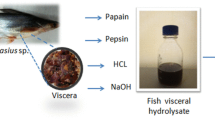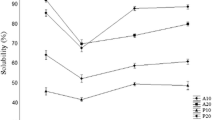Abstract
Fish protein hydrolysates are digested form of protein with various bioactive properties where, the cleavages of molecular bonds of proteins can be broken by the enzymatic and chemical process. In this study, antioxidant properties of spray dried protein hydrolysate prepared from Pangasius viscera by using enzymatic (papain and pepsin), and chemical methods (hydrochloric acid and sodium hydroxide) were evaluated. Among the different treatments, pepsin-derived visceral protein hydrolysate showed the maximum antioxidant activity when used at higher concentrations. Essential amino acids (EAA) and hydrophobic amino acids are higher in papain-derived visceral protein hydrolysate. In pepsin-derived visceral protein hydrolysate, major proportion was contributed by glycine (Gly), glutamine (Glu), proline (Pro), and asparagine (Asp). Higher amount of aromatic amino acids are found in alkali-derived FVPH. Scanning electron microscopy (SEM) images of pepsin fish visceral protein hydrolysate showed better globular structure than the other treatments. It can be concluded that among the different treatments, the visceral protein hydrolysate prepared with pepsin had better overall quality regarding antioxidant properties and papain in nutritional point of view.





Similar content being viewed by others
References
Al-Jowder O, Defernez M, Kemsley EK, Wilson RH (1999) Mid-infrared spectroscopy and chemometrics for the authentication of meat products. J Agric Food Chem 47(8):3210–3218
Amiza MA, Kong YL, Faazaz AL (2012) Effects of degree of hydrolysis on physicochemical properties of Cobia (Rachycentron canadum) frame hydrolysate. Int Food Res J 19(1):199–206
Barth A (2007) Infrared spectroscopy of proteins. Biochimica et Biophysica Acta (BBA) – Bioenergetics 1767:1073–1101
Binsan W, Benjakul S, Visessanguan W, Roytrakul S, Tanaka M, Kishimura H (2008) Antioxidative activity of Mungoong, an extract paste, from the cephalothorax of white shrimp (Litopenaeus vannamei). Food Chem 106(1):185–193
Bougatef A, Hajji M, Balti R, Lassoued I, Triki-Ellouz Y, Nasri M (2009) Antioxidant and free radical-scavenging activities of smooth hound (Mustelus mustelus) muscle protein hydrolysates obtained by gastrointestinal proteases. Food Chem 114(4):1198–1205
Bougatef A, Nedjar-Arroume N, Manni L, Ravallec R, Barkia A, Guillochon D, Nasri M (2010) Purification and identification of novel antioxidant peptides from enzymatic hydrolysates of sardinelle (Sardinella aurita) by-products proteins. Food Chem 118(3):559–565
Chalamaiah M, Hemalatha R, Jyothirmayi T (2012) Fish protein hydrolysates: proximate composition, amino acid composition, antioxidant activities and applications: a review. Food Chem 135(4):3020–3038
Chang CY, Wu KC, Chiang SH (2007) Antioxidant properties and protein compositions of porcine haemoglobin hydrolysates. Food Chem 100(4):1537–1543
Chen X, Ru Y, Chen F, Wang X, Zhao X, Ao Q (2013) FTIR spectroscopic characterization of soy proteins obtained through AOT reverse micelles. Food Hydrocoll 31(2):435–437
Chi CF, Cao ZH, Wang B, Hu FY, Li ZR, Zhang B (2014) Antioxidant and functional properties of collagen hydrolysates from Spanish mackerel skin as influenced by average molecular weight. Molecules 19(8):11211–11230
Cumby N, Zhong Y, Naczk M, Shahidi F (2008) Antioxidant activity and water-holding capacity of canola protein hydrolysates. Food Chem 109(1):144–148
Dhanabalan V, Xavier M, Kannuchamy N, Asha KK, Singh CB, Balange A (2017) Effect of processing conditions on degree of hydrolysis, ACE inhibition, and antioxidant activities of protein hydrolysate from Acetes indicus. Environ Sci Pollut R 24(26):21222–21232
Elavarasan K, Shamasundar BA, Badii F, Howell N (2016) Angiotensin I-converting enzyme (ACE) inhibitory activity and structural properties of oven-and freeze-dried protein hydrolysate from fresh water fish (Cirrhinus mrigala). Food Chem 206:210–216
Galla NR, Pamidighantam PR, Akula S, Karakala B (2012) Functional properties and in vitro antioxidant activity of roe protein hydrolysates of Channa striatus and Labeo rohita. Food Chem 135(3):1479–1484
Gómez-Ruiz JÁ, López-Expósito I, Pihlanto A, Ramos M, Recio I (2008) Antioxidant activity of ovine casein hydrolysates: identification of active peptides by HPLC–MS/MS. Eur Food Res Technol 227(4):1061–1067
Guerard F, Guimas L, Binet A (2002) Production of tuna waste hydrolysates by a commercial neutral protease preparation. J Mol Catal B Enzym 19:489–498
Hassan MA, Deepitha RP, Xavier KM, Gupta S, Nayak BB, Balange AK (2018) Evaluation of the properties of spray dried visceral protein hydrolysate from Pangasianodon hypophthalmus (Sauvage, 1978) extracted by enzymatic and chemical methods. Waste Biomass Valor:1–12. https://doi.org/10.1007/s12649-018-0302-1
Hernández-Ledesma B, Miralles B, Amigo L, Ramos M, Recio I (2005) Identification of antioxidant and ACE-inhibitory peptides in fermented milk. J Sci Food Agric 85(6):1041–1048
Ishida Y, Fujita T, Asai K (1981) New detection and separation method for amino acid by high-preformance liquid chromatogaphy. J Chromatogr 204:143–148
Jamdar SN, Rajalakshmi V, Pednekar MD, Juan F, Yardi V, Sharma A (2010) Influence of degree of hydrolysis on functional properties, antioxidant activity and ACE inhibitor activity of peanut protein hydrolysate. Food Chem 121(1):178–184
Jamilah B, Tan KW, Hartina MU, Azizah A (2011) Gelatins from three cultured freshwater fish skins obtained by liming process. Food Hydrocoll 25(5):1256–1260
Je JY, Qian ZJ, Lee SH, Byun HG, Kim SK (2008) Purification and antioxidant properties of big eye tuna (Thunnus obesus) dark muscle peptide on free radical-mediated oxidative systems. J Med Food 11(4):629–637
Jiang H, Tong T, Sun J, Xu Y, Zhao Z, Liao D (2014) Purification and characterization of antioxidative peptides from round scad (Decapterus maruadsi) muscle protein hydrolysate. Food Chem 154:158–163
Jun SY, Park PJ, Jung WK, Kim SK (2004) Purification and characterization of an antioxidative peptide from enzymatic hydrolysate of yellow fin sole (Limanda aspera) frame protein. Eur Food Res Technol 219(1):20–26
Kim SK, Mendis E (2006) Bioactive compounds from marine processing by-products–a review. Food Res Int 39(4):383–393
Kim SY, Je JY, Kim SK (2007) Purification and characterization of antioxidant peptide from hoki (Johnius belengerii) frame protein by gastrointestinal digestion. J Nutr Biochem 18(1):31–38
Kittiphattanabawon P, Benjakul S, Visessanguan W, Shahidi F (2012) Gelatin hydrolysate from blacktip shark skin prepared using papaya latex enzyme: antioxidant activity and its potential in model systems. Food Chem 135(3):1118–1126
Klompong V, Benjakul S, Kantachote D, Shahidi F (2007) Antioxidative activity and functional properties of protein hydrolysate of yellow stripe trevally (Selaroides leptolepis) as influenced by the degree of hydrolysis and enzyme type. Food Chem 102(4):1317–1327
Klompong V, Benjakul S, Yachai M, Visessanguan W, Shahidi F, Hayes KD (2009) Amino acid composition and antioxidative peptides from protein hydrolysates of yellow stripe trevally (Selaroides leptolepis). J Food Sci 74(2):126–133
Kong J, Yu S (2007) Fourier transform infrared spectroscopic analysis of protein secondary structures. Acta Biochim Biophys Sin 39(8):549–559
Kristinsson HG (1998) Reaction kinetics, biochemical and functional properties of salmon muscle proteins hydrolyzed by different alkaline proteases (Doctoral dissertation, University of Washington)
Lee SJ, Kim YS, Hwang JW, Kim EK, Moon SH, Jeon BT, Jeon YJ, Kim JM, Park PJ (2012) Purification and characterization of a novel antioxidative peptide from duck skin by-products that protects liver against oxidative damage. Food Res Int 49(1):285–295
Liceaga-Gesualdo AM, Li-Chan ECY (1999) Functional properties of fish protein hydrolysate from herring (Clupea harengus). J Food Sci 64(6):1000–1004
Luo HY, Wang B, Li ZR, Chi CF, Zhang QH, He GY (2013) Preparation and evaluation of antioxidant peptide from papain hydrolysate of Sphyrna lewini muscle protein. Food Sci and Technol 51(1):281–288
Nasri R, Younes I, Jridi M, Trigui M, Bougatef A, Nedjar-Arroume N, Karra-Châabouni M (2013) ACE inhibitory and antioxidative activities of Goby (Zosterissessor ophiocephalus) fish protein hydrolysates: effect on meat lipid oxidation. Food Res Int 54(1):552–561
Ovissipour M, Abedian A, Motamedzadegan A, Rasco B, Safari R, Shahiri H (2009) The effect of enzymatic hydrolysis time and temperature on the properties of protein hydrolysates from Persian sturgeon (Acipenser persicus) viscera. Food Chem 115(1):238–242
Park PJ, Jung WK, Nam KS, Shahidi F, Kim SK (2001) Purification and characterization of antioxidative peptides from protein hydrolysate of lecithin-free egg yolk. J Am Oil Chem Soc 78(6):651–656
Pihlanto-Leppälä A (2000) Bioactive peptides derived from bovine whey proteins: opioid and ace-inhibitory peptides. Trends Food Sci Technol 11(9):347–356
Putra SNKM, Ishak NH, Sarbon NM (2017) Preparation and characterization of physicochemical properties of golden apple snail (Pomacea canaliculata) protein hydrolysate as affected by different proteases. Bio Agri Biotechnol 13:123–128
Qian ZJ, Je JY, Kim SK (2007) Antihypertensive effect of angiotensin I converting enzyme-inhibitory peptide from hydrolysates of bigeye tuna dark muscle, Thunnus obesus. J Agric Food Chem 55(21):8398–8403
Qian J, Tang Q, Cronin B, Markovich R, Rustum A (2008) Development of a high performance size exclusion chromatography method to determine the stability of Human Serum Albumin in a lyophilized formulation of Interferon alfa-2b. J Chromatogr A 1194(1):48–56
Ranathunga S, Rajapakse N, Kim SK (2006) Purification and characterization of antioxidative peptide derived from muscle of conger eel (Conger myriaster). Eur Food Res Technol 222(3-4):310–315
Riisom T, Sims RJ, Fioriti JA (1980) Effect of amino acids on the autoxidation of safflower oil in emulsions. J Am Oil Chem Soc 57(10):354–359
Rosenberg M, Young SL (1993) Whey proteins as microencapsulating agents. Microencapsulation of anhydrous milkfat-structure evaluation. Food Struct 12(1):4
Sarmadi BH, Ismail A (2010) Antioxidative peptides from food proteins: a review. Peptides 31(10):1949–1956
Sathivel S, Prinyawiwatkul W, King JM, Grimm CC, Lloyd S (2003) Oil production from catfish viscera. J Am Oil Chem Soc 80(4):377–382
Sathivel S, Smiley S, Prinyawiwatkul W, Bechtel PJ (2005) Functional and nutritional properties of red salmon (Oncorhynchus nerka) enzymatic hydrolysates. J Food Sci 70(6)
Shahidi F, Zhong Y (2010) Novel antioxidants in food quality preservation and health promotion. Eur J Lipid Sci Technol 112(9):930–940
Shahidi F, Han XQ, Synowiecki J (1995) Production and characteristics of protein hydrolysates from capelin (Mallotus villosus). Food Chem 53(3):285–293
Shimada K, Fujikawa K, Yahara K, Nakamura T (1992) Antioxidative properties of xanthan on the autoxidation of soybean oil in cyclodextrin emulsion. J Agric Food Chem 40(6):945–948
Tan ES, Ying-Yuan N, Gan CY (2014) A comparative study of physicochemical characteristics and functionalities of pinto bean protein isolate (PBPI) against the soybean protein isolate (SPI) after the extraction optimisation. Food Chem 152:447–455
Tang CH, Peng J, Zhen DW, Chen Z (2009) Physicochemical and antioxidant properties of buckwheat (Fagopyrum esculentum Moench) protein hydrolysates. Food Chem 115(2):672–678
Tannenbaum SR, Ahern M, Bates RP (1970) Solubilization of fish protein concentrate. I. An alkaline process. Food Technol 24(5):604
Tanuja S, Viji P, Zynudheen AA, Joshy C (2012) Composition, functional properties and antioxidative activity of hydrolysates prepared from the frame meat of Striped catfish (Pangasianodon hypophthalmus). Egypt J Biol 14(1):27–35
Tsugita A, Scheffler JJ (1982) A rapid method for acid hydrolysis of protein with a mixture of trifluoroacetic acid and hydrochloric acid. The FEBS J 124(3):585–588
Uchida K, Kawakishi S (1992) Sequence-dependent reactivity of histidine-containing peptides with copper (II)/ascorbate. J Agric Food Chem 40(1):13–16
Wasswa J, Tang J, Gu XH, Yuan XQ (2007) Influence of the extent of enzymatic hydrolysis on the functional properties of protein hydrolysate from grass carp (Ctenopharyngodon idella) skin. Food Chem 104(4):1698–1704
Wu HC, Chen HM, Shiau CY (2003) Free amino acids and peptides as related to antioxidant properties in protein hydrolysates of mackerel (Scomber austriasicus). Food Res Int 36(9):949–957
Zhu K, Zhou H, Qian H (2006) Antioxidant and free radical-scavenging activities of wheat germ protein hydrolysates (WGPH) prepared with alcalase. Process Biochem 41(6):1296–1130
Acknowledgements
The authors thank the Director, ICAR-Central Institute of Fisheries Education, Mumbai. The Maulana Azad National Fellowship given by UGC, India, to the first author is gratefully acknowledged.
Author information
Authors and Affiliations
Corresponding author
Additional information
Responsible editor: Philippe Garrigues
Publisher’s note
Springer Nature remains neutral with regard to jurisdictional claims in published maps and institutional affiliations.
Highlights
• Pangasius visceral protein hydrolysate prepared by enzymatic and chemical methods.
• Spray dried powder was evaluated for antioxidant instrumental quality traits.
• FVPH prepared with pepsin showed higher antioxidant activity.
• Essential amino acids are higher with papain-derived FVPH.
Rights and permissions
About this article
Cite this article
Hassan, M.A., Xavier, M., Gupta, S. et al. Antioxidant properties and instrumental quality characteristics of spray dried Pangasius visceral protein hydrolysate prepared by chemical and enzymatic methods . Environ Sci Pollut Res 26, 8875–8884 (2019). https://doi.org/10.1007/s11356-019-04144-y
Received:
Accepted:
Published:
Issue Date:
DOI: https://doi.org/10.1007/s11356-019-04144-y




